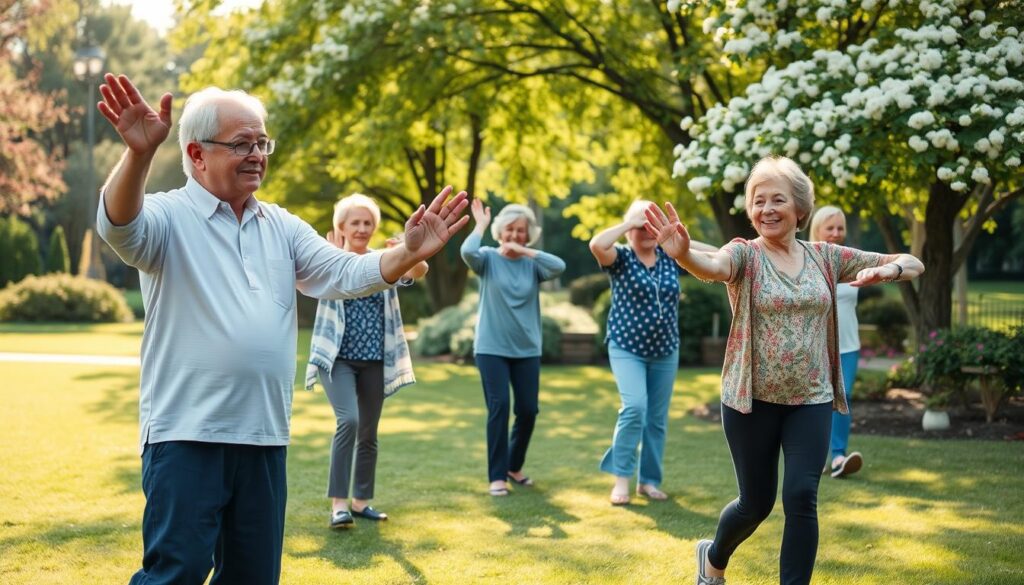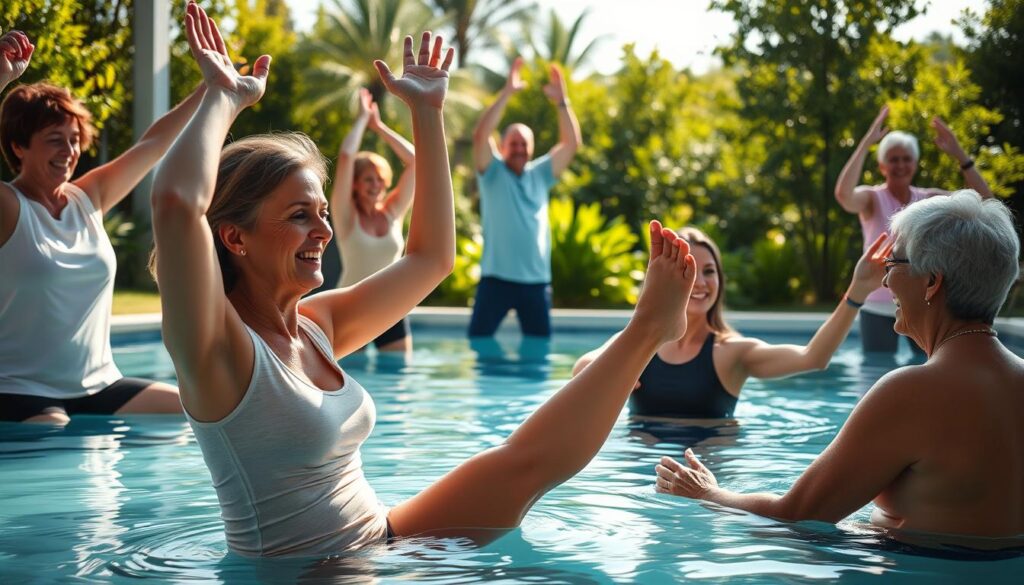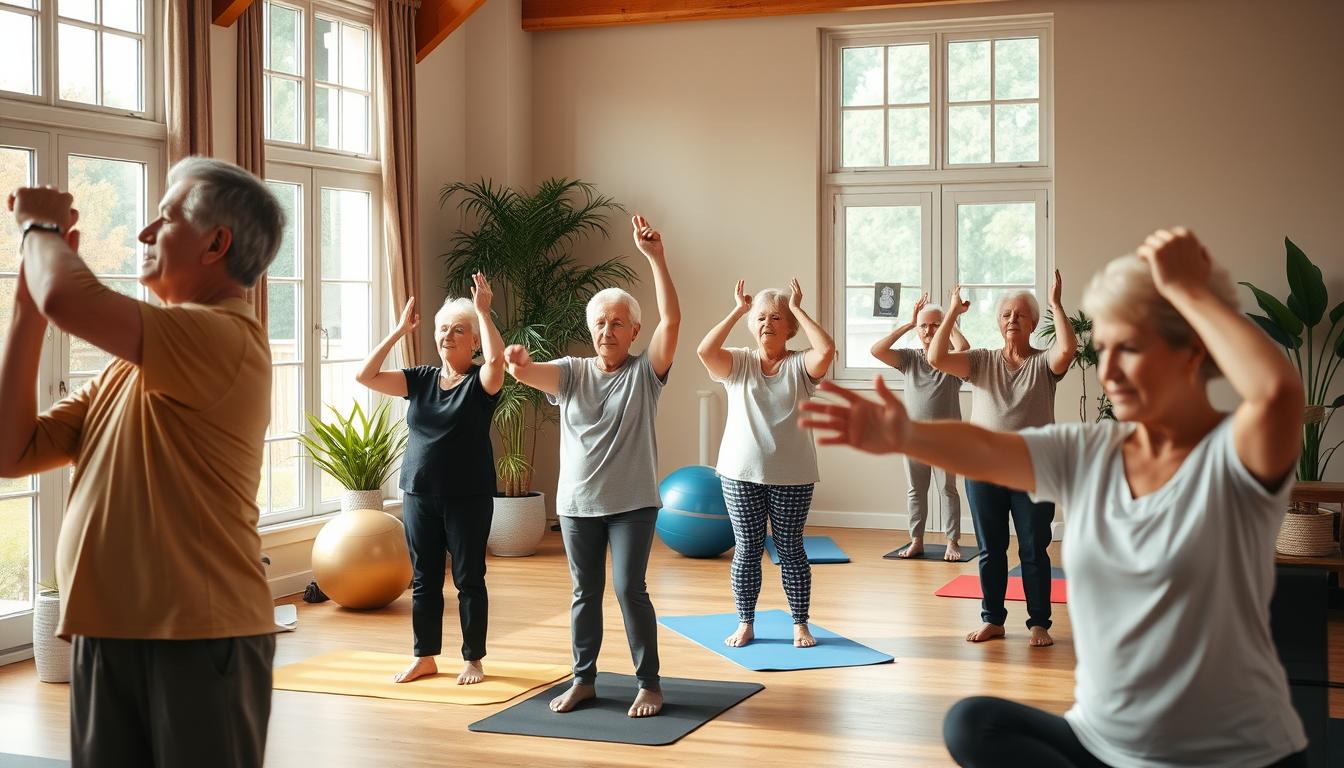Do you have arthritis and find it hard to exercise? You're not alone. Many people with arthritis avoid moving because of pain and stiffness. But, staying active is key to managing your symptoms and improving your life1? You can develop the motivation for exercising with arthritis.
Exercise can make your joints feel better, build muscle, help control your weight, and boost your mood. It's important to be careful and talk to your doctor first. But, the good things about exercising for arthritis often make it worth it1. So, why not start exercising? Let's look at the strong reasons to exercise with arthritis and find ways to stay active and succeed1.
Understanding the Benefits of Exercise for Arthritis
Reducing Symptoms and Improving Quality of Life
Exercise is great for managing arthritis symptoms. It helps with both wear-and-tear osteoarthritis and inflammatory rheumatoid arthritis2. Regular activity adds fluid to joints, reducing swelling and pain2.
Motivation for exercising with arthritis builds muscle strength, which supports joints and eases pressure2. Keeping a healthy weight through exercise also helps reduce joint stress2.
Exercise can also lower anxiety and depression in people with osteoarthritis, improving their overall well-being2. The American College of Sports Medicine suggests doing moderate-intensity exercise three to five times a week2.
Mixing strength training, flexibility exercises, and low-impact activities can manage arthritis symptoms and enhance life quality2.
Osteoarthritis patients often fear exercising might harm their joints3. But, regular strength and mobility exercises can actually relieve pain and improve joint function in just a few weeks3.
Endurance exercises like brisk walking, cycling, and low-impact sports can strengthen muscles and improve joint health3.
Physical therapy, functional fitness training, and supervised exercise classes offer great benefits for arthritis patients3. These programs provide guidance and support, helping patients exercise safely and effectively without causing discomfort3.
"Regular exercise can have a significant impact on health and well-being for individuals with arthritis."4
By adding exercise to their daily routine, arthritis patients can see less swelling, better sleep, and improved mood and independence4. An initial increase in discomfort or stiffness is normal but usually settles within a day or so4.
Regular and tailored exercise programs are a powerful tool for managing arthritis symptoms and improving life quality for those with this condition234.
Building Muscle Strength and Controlling Weight
With motivation for exercising with arthritis is key for managing symptoms and building muscle strength. Strong muscles support the joints, reducing pressure and strain5. Physical activity also reduces pain, improves function, and boosts quality of life for those with knee and/or hip osteoarthritis5.
Strength training is especially good for people with arthritis5. It can lessen pain and improve cartilage health, among other benefits5. The Centers for Disease Control and Prevention suggest older adults do muscle strengthening exercises two days a week6.
Keeping a healthy weight through exercise also helps reduce joint stress5. Many adults with osteoarthritis also have other chronic conditions like diabetes and obesity5. Exercise can help manage weight, improve sleep, and reduce the risk of falling5.
| Fitness Metric | Recommended Targets |
|---|---|
| Aerobic Activity | 150 minutes of moderate activity or 75 minutes of vigorous activity per week7 |
| Strength Training | At least 2 days per week for all major muscle groups76, |
| Sleep | 7-9 hours per night6 |
| Water Intake | 6-8 glasses per day6 |
| Protein Intake | Lean sources like poultry, fish, beans, and nuts6 |
By doing a balanced exercise routine and keeping a healthy weight, people with arthritis can manage their symptoms better. This improves their health and quality of life5. Start slowly, increase intensity and duration gradually, and listen to your body to avoid injuries and stay motivated7.
Enhancing Mental Health and Well-being
Exercise is key for both your body and mind, especially if you have arthritis. Studies show that moving your body can lower anxiety and depression in people with osteoarthritis8. It makes life better for those dealing with arthritis.
Exercise is as good as some medicines for mild to moderate depression9. It also helps with ADHD, making you focus, feel motivated, and remember things better9.
Even small amounts of exercise, like walking with a friend, can help a lot9. Starting with simple activities like walking or dancing is a great way to begin, even if you're new to exercise9.
Regular exercise can make you feel less tired and more energetic9. It also fights off depression and boosts your mood, especially with activities like walking, jogging, yoga, and strength training8.
Adding exercise to your daily routine improves your physical and mental health. It helps you manage the challenges of arthritis better89.

"Movement can help reduce symptoms of depression and prevent clinical depression, even with just a few minutes of physical activity per day."8
Fostering Social Connections Through Exercise
Joining group classes can be a great motivation for exercising with arthritis, or doing activities with friends can make you feel less lonely8. People who exercise two days a week also feel more confident and aware of their bodies8.
| Exercise Type | Mental Health Benefits |
|---|---|
| Walking, Jogging | Reduces symptoms of depression and improves mood |
| Yoga | Alleviates stress and anxiety, enhances mindfulness |
| Strength Training | Boosts self-esteem and body awareness |
Motivation for Exercising with Arthritis
It's hard to stay motivated to exercise with arthritis. Pain, stiffness, and tiredness make it easy to skip workouts. But, studies show that exercise is key to managing arthritis and feeling better10.
A big problem is that many people with hip and knee osteoarthritis don't exercise enough. This shows a big gap in exercise habits in this group10.
To beat the challenges of exercising with arthritis, you need a plan. A plan that ensures your motivation for exercising with arthritis. Work with your doctor to create an exercise routine that fits your needs10. GLA:D® Australia's 2019 report shows how exercise and education can help those with knee osteoarthritis10.
Setting achievable goals and finding fun activities can help you stay active10. A study by Bell et al. found that the GLA:D® program boosts physical activity and function in people with knee osteoarthritis10. Using motivational strategies, like those in Gilbert et al.'s trial, can also help increase physical activity and improve function in adults with arthritis10.
Motivation for exercising with arthritis by facing the challenges and showing motivation for exercising, you can manage your arthritis symptoms and enhance your life quality10. Li et al.'s study on a wearable-based program for knee osteoarthritis showed its positive effects on participants' outcomes10.
Best and Worst Exercises for Arthritis
Motivation for exercising with arthritis shows that some exercises are better than others for people with arthritis. Low-impact cardio, gentle stretching, and strength training are great1111. But, high-impact activities like running and heavy lifting should be avoided unless a doctor says it's okay11.
Low-impact Activities to Promote Joint Health
Walking, swimming, and chair yoga are good for people with arthritis12. Studies show that walking more helps keep joints working better12. It also helps maintain a healthy weight, which reduces joint stress12.
Start with a 10-minute walk and increase it over time12. Warm up before walking to prevent injuries12. Using heat, massages, and icing can also help manage pain12.
Listen to your body when starting new exercises12. If you feel sharp pain, you might be doing too much12. Keeping a progress journal and walking with friends can keep you motivated12.
| Best Exercises for Arthritis | Worst Exercises for Arthritis |
|---|---|
|
|

"The goal for walking is to work up to 30 minutes, 5 days a week, with the option of splitting the time into shorter walks."12
Tips for Exercising with Arthritis
Exercising with arthritis needs careful planning for the best results. Begin by talking to your healthcare team, like your doctor and a physical therapist. They can help create an exercise plan just for you13. This plan will help you slowly get stronger and avoid hurting your joints.
Before exercising, warm up with heat to loosen stiff joints. Then, cool down with ice to lessen soreness14. Listen to your body and adjust your routine if needed. Staying motivated is important, so pick exercises you like and consider exercising with a friend15.
It's crucial to start slowly and build up your strength and flexibility. By following these tips and working with your healthcare team, you can improve your exercise routine. This will help you feel better, build your motivation for exercising with arthritis, and ensure you live a healthier life131415.
Source Links
- 5 Tips to Get You Moving - https://www.ncoa.org/article/5-tips-to-help-older-adults-stay-motivated-to-exercise/
- Arthritis Tips: Exercise Your Way to Better Joints | Banner - https://www.bannerhealth.com/healthcareblog/better-me/tips-for-easing-arthritis-and-joint-pain-with-exercise
- Osteoarthritis of the knee: Learn More – What can you do to strengthen your knees? - InformedHealth.org - https://www.ncbi.nlm.nih.gov/books/NBK544978/
- How exercise can ease arthritis pain - https://www.thebodycoach.com/blog/how-exercise-can-ease-arthritis-pain/
- The Critical Role of Physical Activity and Weight Management in Knee and Hip Osteoarthritis: A Narrative Review - https://www.jrheum.org/content/51/3/224
- It’s not too late to start a strength exercise routine: How older adults can build muscle after age 60 and beyond - https://nortonhealthcare.com/news/seniors-guide-to-improved-muscle-tone/
- 5 steps to start a fitness program - https://www.mayoclinic.org/healthy-lifestyle/fitness/in-depth/fitness/art-20048269
- Exercise and Mental Health: 8 Benefits for Your Mood - https://www.hingehealth.com/resources/articles/exercise-and-mental-health/
- The Mental Health Benefits of Exercise - HelpGuide.org - https://www.helpguide.org/wellness/fitness/the-mental-health-benefits-of-exercise
- Original research: Using SUpported Motivational InTerviewing (SUMIT) to increase physical activity for people with knee osteoarthritis: a pilot, feasibility randomised controlled trial - https://www.ncbi.nlm.nih.gov/pmc/articles/PMC10668304/
- How to Stay Fit with Chronic Pain as You Age - https://www.ncoa.org/article/staying-fit-with-age-related-pain-top-5-tips-for-older-adults/
- Your Osteoarthritis Walking Plan: How to Get Started - https://www.webmd.com/osteoarthritis/oa-start-walking-program
- Exercise Tips for Older Adults With Arthritis | UT Physicians - https://www.utphysicians.com/exercises-older-adults-with-arthritis-can-do-at-home/
- How to Exercise With Rheumatoid Arthritis|Everyday Health - https://www.everydayhealth.com/hs/rheumatoid-arthritis-treatment-management/exercise-tips/
- Physical activity | Arthritis Ireland - https://www.arthritisireland.ie/physical-activity

[…] Benefits of Exercise for Arthritis […]